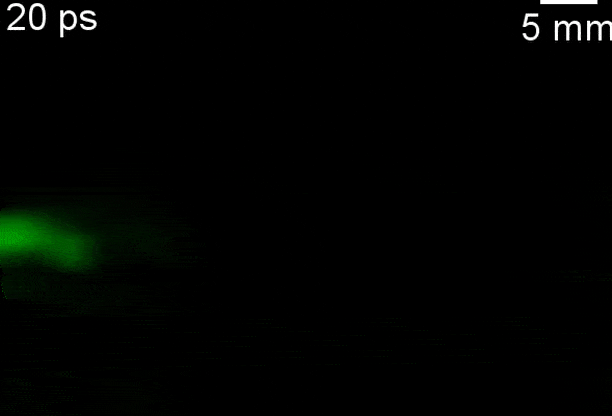
A fighter jet photographed in the midst of a sonic boom. The plane travels faster than the sound it emits. As it pierces the sound wave, a roaring boom commences. Credit: YouTube capture.
Though modern fighter jets are stealthier than ever, they’re hardly inconspicuous once accelerating past the sound barrier. By reaching Mach speeds (faster than 340 meters/second), jets essentially travel faster than sound pressure waves. When the jet crashes into the pressure wave it had just emitted, a nearly deafening ‘sonic boom’ is triggered that can be heard for miles. Though far less spectacular, the same thing essentially also happens with light when it travels faster than the wave it emitted. Now, using the most advanced ultra-speed cameras, scientists have filmed light’s Mach cone for the first time.
Per Einstein’s Theory of Special Relativity, nothing can travel faster than light. But that doesn’t mean light can’t travel slower than c (300,000 kilometers/second). In fact, scientists have previously shown its possible to slow down light to 0.001 percent of c, making it almost look like it’s floating.
The experiment carried out by a team at Washington University was far less extreme and involved the basic knowledge that photons travel slower through some mediums than others. In between two plates made of silicone rubber and powdered aluminum oxide respectively, the researchers sandwiched dry-ice fog. Light was then fired through a channel that pierced the two plates.
This technique enabled the researchers to witness a photonic boom for the first time in video because the light moves slower through the walls of the tunnel than the fog. The footage we’re seen was recorded with a camera that films at a trillion frames per second. The same camera has been previously used to film light in slow motion, providing a unique glimpse into how rays of light actually look like.
The Washington University team claims the technique they just demonstrated might prove useful for imaging ultrafast events, even those in the human body.
“Our camera is fast enough to watch neurons fire and image live traffic in the brain,” optical engineer Jinyang Liang from Washington University told Live Science.
“We hope we can use our system to study neural networks to understand how the brain works.”











